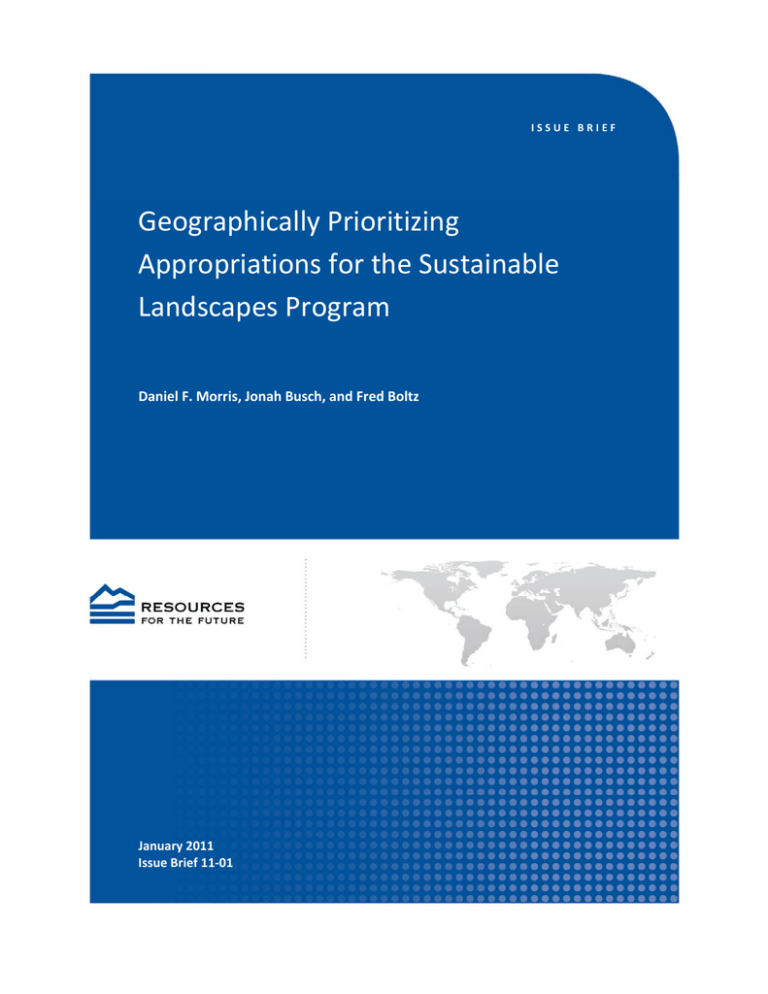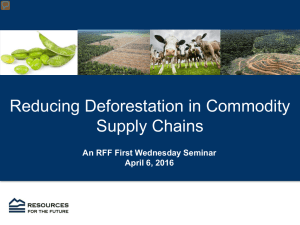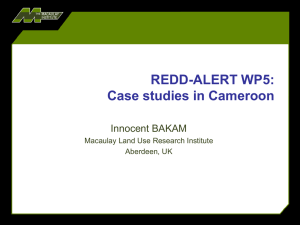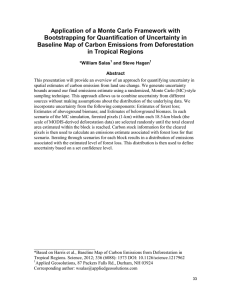Geographically Prioritizing Appropriations for the Sustainable Landscapes Program
advertisement

Date Issue Brief # ISSUE BRIEF Geographically Prioritizing Appropriations for the Sustainable Landscapes Program Daniel F. Morris, Jonah Busch, and Fred Boltz January 2011 Issue Brief 11‐01 Resources for the Future Resources for the Future is an independent, nonpartisan think tank that, through its social science research, enables policymakers and stakeholders to make better, more informed decisions about energy, environmental, natural resource, and public health issues. Headquartered in Washington, DC, its research scope comprises programs in nations around the world. 2 MORRIS, BUSCH, AND BOLTZ | RESOURCES FOR THE FUTURE Geographically Prioritizing Appropriations for the Sustainable Landscapes Program Daniel F. Morris, Jonah Busch, and Fred Boltz 1 At the 16th Conference of the Parties to the United Nations Framework Convention on Climate Change (UNFCCC) in Cancun, the Obama administration reiterated its pledge of a combined $1 billion in fast‐start financing for FY2010 through FY2012 to assist developing nations reduce emissions from deforestation. These funds will be delivered through the framework of Reduced Emissions from Deforestation and Degradation Plus (REDD+), a broad concept developed by the UNFCCC to encompass activities that reduce greenhouse gas emissions from deforestation and forest degradation, conserve and enhance forest carbon stocks, and sustainably manage forests. The U.S. REDD+ strategy released in December 2010 that will guide the distribution of fast‐start funds through programs like the Sustainable Landscapes Program has three objectives: Objective 1: REDD+ Architecture: Create and support an efficient, effective, and coordinated international system to help countries deliver REDD+ outcomes. Objective 2: REDD+ Readiness: Help countries become ready to participate in pay‐for‐ performance programs and take complementary domestic actions. Objective 3: REDD+ Demonstration: Achieve cost‐effective and sustainable net emissions reductions. Objectives 2 and 3 will direct how U.S. government expenditures are made to specific developing countries. Emissions from deforestation and degradation are not distributed evenly throughout …………………………………. 1 Morris is a center fellow at the Center for Climate and Electricity Policy at Resources for the Future, Busch is a climate and forest economist at Conservation International, and Boltz is a senior vice president for Global Initiatives at Conservation International. 1 MORRIS, BUSCH, AND BOLTZ | RESOURCES FOR THE FUTURE the tropics. Indeed, a select number of countries have tremendous potential to contribute to climate solutions through improved land use and forestry activities. These are the countries that have large, carbon‐rich forests and have—or are at risk of having—high deforestation rates. The bulk of initial fast‐start financing should be directed to key countries with disproportionally high potential for protecting global forests and reducing emissions in accordance with Objective 3. Beyond that, appropriations should be spread broadly among a larger group of critical forest countries to establish incentives for mitigating deforestation and preparing for future national REDD+ programs, as suggested by Objective 2. This paper presents recommendations for geographically prioritizing USAID expenditures to achieve Objectives 2 and 3. Our analysis synthesizes the results of two leading economic models of international REDD+ supply (the Forest Carbon Index [FCI], Deveny et al. 2009; and OSIRIS, Busch et al. 2009)2. We identify countries that rank highly within both models based on their potential to protect forest resources from destruction immediately, their potential to avoid deforestation threats in the future, and their ability to present cost‐effective alternatives to forest conversion. The recommendations presented here are based strictly on countries’ potential carbon value as calculated by the two tools and do not include other important considerations such as ancillary benefits for biodiversity and broader ecosystem service conservation or poverty alleviation. The 27 priority countries highlighted in the map below are likely to provide the best opportunities for success for Sustainable Landscapes funding in terms of this program’s focus on emissions mitigation. …………………………………. 2 2 See www.forestcarbonindex.org and www.conservation.org/osiris. MORRIS, BUSCH, AND BOLTZ | RESOURCES FOR THE FUTURE The map identifies countries in three distinct categories: 3 Reducing Current Deforestation (corresponds to Objective 3): These countries would have the highest impact in terms of forest‐based climate solutions and should receive a large proportion of U.S. government appropriations to establish national programs and large‐scale demonstration projects. The following 7 countries were identified by both the OSIRIS and FCI models as among the top 10 for potential to reduce current emissions from deforestation. These 7 countries account for 40 percent of total forest carbon stock (in potential REDD+ countries) and 57 percent of total annual forest carbon emissions: o Brazil o Malaysia o Ecuador o Mexico o Honduras o Zambia o Indonesia Avoiding Future Deforestation (corresponds to Objective 2): These countries possess major forest stocks which are not yet under threat of significant deforestation, but are likely candidates for future deforestation emissions based on their supply of large intact forests. A strategic proportion of U.S. government investment should support national REDD+ program development and capacity building in these countries to reduce the likelihood that they will experience increased deforestation in future years. The following 6 countries were identified by both the OSIRIS and the FCI models as among the top 10 for potential to avoid future supplies of forest carbon emissions. These 6 countries account for an additional 21 percent of total forest carbon stock: o Angola o Democratic Republic of Congo o Colombia o Gabon o Congo o Peru Potential REDD+ Investment: Countries in this category are also rich in forest carbon, but are identified as less urgent than the countries listed in the previous two categories. These countries should receive some funding for capacity building and REDD+ program development from U.S. government appropriations. They may also be viable alternative fund recipients if countries in the first two categories are deemed unsuitable. The following 14 countries were identified as among the top 40 investment countries by OSIRIS. They are also among the top 20 countries for reducing current deforestation or among the top 10 countries for avoiding future deforestation by FCI. These 14 countries account for an additional 15 percent of total forest carbon stock and 14 percent of total annual forest carbon emissions: o Mozambique o Argentina o Bolivia o Nicaragua o Cameroon o Nigeria o Central African Republic o Papua New Guinea o Paraguay o Coté d’Ivoire o Ghana o Tanzania o Guyana o Venezuela MORRIS, BUSCH, AND BOLTZ | RESOURCES FOR THE FUTURE If federal priorities emphasize getting demonstration projects up and running as soon as possible, then the 7 nations in the “Reducing current deforestation” category should take funding precedence. The 6 countries listed under “Avoid Future Deforestation” represent the highest priorities for funding under Objective 2. Countries in the “Potential REDD+ Investment” category should receive some capacity‐building funds now, but represent more long‐term opportunities for deforestation programs. Methodology for Country Prioritizations and Model Synthesis OSIRIS OSIRIS (Busch et al. 2009) is an 85‐country partial equilibrium model for estimating country‐by‐ country rates of deforestation, emissions from deforestation, REDD+ revenue, and cost‐efficiency of emissions reductions under alternative international REDD+ policy scenarios. In the OSIRIS economic model, agriculture and timber compete with forests for the use of tropical frontier land. OSIRIS incorporates commodity price feedback, leakage of deforestation, and REDD design‐ specific national participation incentives using global data on forest cover (FAO 2005), forest loss (FAO 2005), carbon density (Ruesch and Gibbs 2008; GSDTG 2000; Schmitt et al. 2008), potential agricultural revenue (Naidoo and Iwamura 2008), timber revenue (Sohngen and Tennity 2004), and governance (FCI 2009). OSIRIS has been developed for comparing alternative REDD+ policies rather than predicting the magnitude of impacts with certainty. For this analysis OSIRIS was used to estimate the “amount of forest carbon at stake” from enabling a country to participate in REDD+. The amount of forest carbon at stake is defined as the difference between the carbon emissions produced if a country is able to participate in REDD+ (in which case the country’s emissions decrease below business‐as‐usual) and those produced if that country is unable to participate in REDD+ (in which case the country’s emissions increase above business‐as‐usual due to leakage, which is a function of a country’s forest area and the agricultural and timber potential of the country’s forest land). To calculate the amount of forest carbon at stake in a country, we compared a scenario in which all countries are eligible to participate in a “full” REDD+ mechanism with $5 per ton of carbon dioxide equivalent and combined incentives reference levels (Strassburg et al. 2009), to a scenario in which only that country was excluded from eligibility to participate in REDD+. A governance hurdle was imposed, such that countries with lower governance required a higher carbon price to make REDD+ revenue equally competitive with agricultural and timber revenue. The top 10 countries for reducing current emissions were those in which the majority of forest carbon at stake was composed of emission reductions from including the country in REDD+. The top 10 countries for avoiding future emissions were those in which roughly half or more of the forest carbon at stake was composed of emissions increases due to leakage from excluding the 4 MORRIS, BUSCH, AND BOLTZ | RESOURCES FOR THE FUTURE country from REDD+. Only those countries predicted to participate in REDD+ were included in these top 10 lists. The top 40 countries for potential REDD+ investment included countries of importance for both reducing current emissions and avoiding future emissions, when a governance hurdle was not imposed. Predicted lack of national participation was not a constraint to inclusion in this list. FOREST CARBON INDEX The Forest Carbon Index (FCI), created by Resources for the Future and Climate Advisers, uses multiple datasets (JRC 2003; Kindermann et al. 2008; Naidoo and Iwamura 2007) to provide governments, development agencies, NGOs, and private investors with geospatial information on global, national, and local forest carbon supply, explicitly taking into account country‐specific economic, biological, and risk factors. The Index estimates the potential of every square kilometer of terrestrial land to generate carbon credits by avoiding deforestation. It brings together for the first time 21 datasets at the national scale and 6 datasets at a gridded subnational scale, integrated and mapped across approximately 1.5 million unique locations at a resolution of 85.5 square kilometers. The FCI combines biological data in the form of aboveground forest carbon with economic data in the form of opportunity costs of avoiding converting forests into agricultural land to generate profit potential for reducing emissions from deforestation at a high resolution across the globe based on a price of $20 per ton of carbon dioxide. The profit potential is then discounted with a risk factor that accounts for the governance, readiness for REDD+ projects, and ease of doing business in each country. In the FCI, profit potential is calculated at the 85.5 square kilometer level and risk factors are applied at country level. For this analysis, we utilized two different analyses from the FCI. To determine the “Reduce Deforestation Now” countries, we employed the FCI “flows” analysis, which uses country‐level deforestation rates as a filter on the base FCI analysis to identify the countries that possess the most at‐risk forest carbon stocks in the short and medium term. Our flows analysis included the FCI Risk Factor filter to account for governance in countries with current high deforestation, which allowed for prioritized investment recommendations for countries that have the highest chance of success. We identified the top 20 countries that would likely supply the most REDD+ credits for immediate investment. Concurrently, our analysis identified 10 countries vulnerable to future clearing pressures as international efforts reduce current deforestation. To identify “Avoid Future Deforestation” nations, we utilized the FCI “stocks” analysis, which calculated the overall potential for a country to generate forest carbon credits. This analysis did not include the FCI Risk Factor because it was important to highlight areas across the globe are prime candidates for leakage. Because the Risk 5 MORRIS, BUSCH, AND BOLTZ | RESOURCES FOR THE FUTURE Factor is a discount filter applied nationally, it was excluded to show the full carbon supply available. Additionally, those countries that were in the top 10 of the flows analysis were not included in the top 10 of the stocks analysis. MODEL SYNTHESIS The countries listed in each category ranked highly in their performance in each of the two models. “Reducing Current Deforestation” countries were identified in the top 10 of OSIRIS’s assessment of countries with forest carbon at stake including a governance hurdle and FCI’s flows analysis with the Risk Factor filter. “Avoid Future Deforestation” countries were identified in the top 10 of the OSIRIS analysis without the governance hurdle and the top 10 of the FCI’s stocks analysis. Any countries that appeared in both top 10 lists were included in the “Reducing Current Deforestation” category. All other countries identified by the OSIRIS and FCI analyses not listed in the first two categories were placed in the “Potential REDD+ Investment” categories. Annex I countries under the Kyoto Protocol were excluded from the analysis. These synthesis results represent of the overlap of countries identified as priorities by two leading economic models, but do not highlight any additional combination of methods or findings. As the United States moves toward fulfilling its funding commitments, systematic analyses by tools like OSIRIS and FCI will continue help U.S. policymakers understand the difference in countries’ abilities to effectively execute and support REDD+ projects. References Busch, J., B. Strassburg, A. Cattaneo, R. Lubowski, A. Bruner, R. Rice, A. Creed, R. Ashton, and F. Boltz. 2009. Comparing Climate and Cost Impacts of Reference Levels for Reducing Emissions from Deforestation. Environmental Research Letters 4: 044006. Deveny, A., J. Nackoney, N. Purvis, R. Kopp, E. Myers, M. Macauley, M. Obersteiner, G. Kindermann, M. Gusti, and A. Stevenson. 2009. Forest Carbon Index: The Geography of Forests in Climate Solutions. Washington, DC: Resources for the Future and Climate Advisers. FAO (U.N. Food and Agriculture Organization). 2005. Global forest resources assessment 2005: Progress towards sustainable forest management. Rome: FAO. GSDTG (Global Soil Data Task Group). 2000. Global gridded surfaces of selected soil characteristics (IGBP‐DIS). International Geosphere‐Biosphere Programme – Data and Information System. Data set. Available online from Oak Ridge National Laboratory Distributed Active Archive Center, Oak Ridge, Tennessee, USA. http://www.daac.ornl.gov. JRC (European Commission Joint Research Centre). 2003. Global Land Cover Map for the Year 2000. GLC2000 Database. Brussels, Belgium: European Commission Joint Research Centre. http://bioval.jrc.ec.europa.eu/products/glc2000/glc2000.php. 6 MORRIS, BUSCH, AND BOLTZ | RESOURCES FOR THE FUTURE Kindermann, G.E., I. McCallum, S. Fritz, and M.Obersteiner. 2008. A Global Forest Growing Stock, Biomass and Carbon Map Based on FAO Statistics. Silva Fennica 42(3): 387–396. Naidoo, R., and T. Iwamura. 2007. Global‐Scale Mapping of Economic Benefits from Agricultural Lands: Implications for Conservation Priorities. Biological Conservation 140: 40–49. Ruesch, A.S., and H.K. Gibbs. 2008. New IPCC Tier‐1 global biomass carbon map for the year 2000. Carbon Dioxide Information Analysis Center, Oak Ridge National Laboratory, Oak Ridge, TN, USA. http://cdiac.ornl.gov/epubs/ndp/global_carbon/carbon_documentation.html. Schmitt, C.B., A. Belokurov, C. Besançon, L. Boisrobert, N.D. Burgess, A. Campbell, L. Coad, L. Fish, D. Gliddon, K. Humphries, et al. 2008. Global Ecological Forest Classification and Forest Protected Area Gap Analysis. Analyses and recommendations in view of the 10% target for forest protection under the Convention on Biological Diversity (CBD). Freiburg, Germany: Freiburg University Press. Sohngen, B. and C. Tennity. 2004. Country specific global forest data set v.1. 7 MORRIS, BUSCH, AND BOLTZ | RESOURCES FOR THE FUTURE





